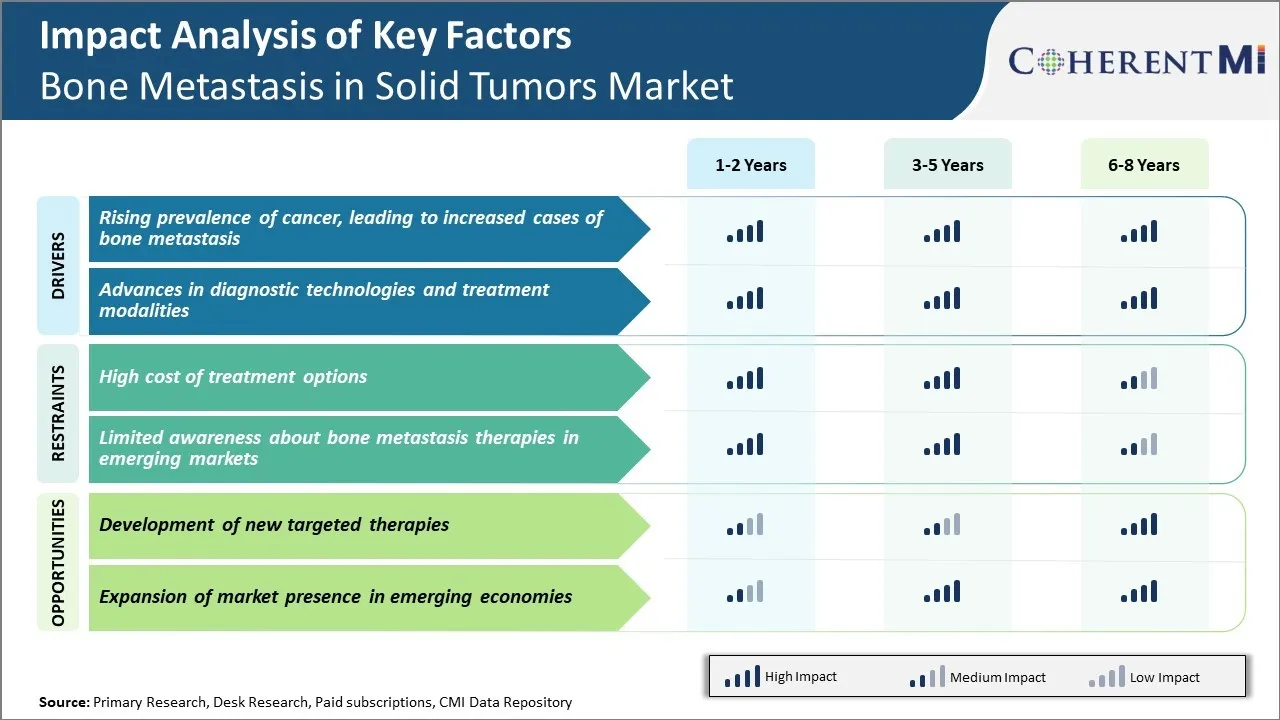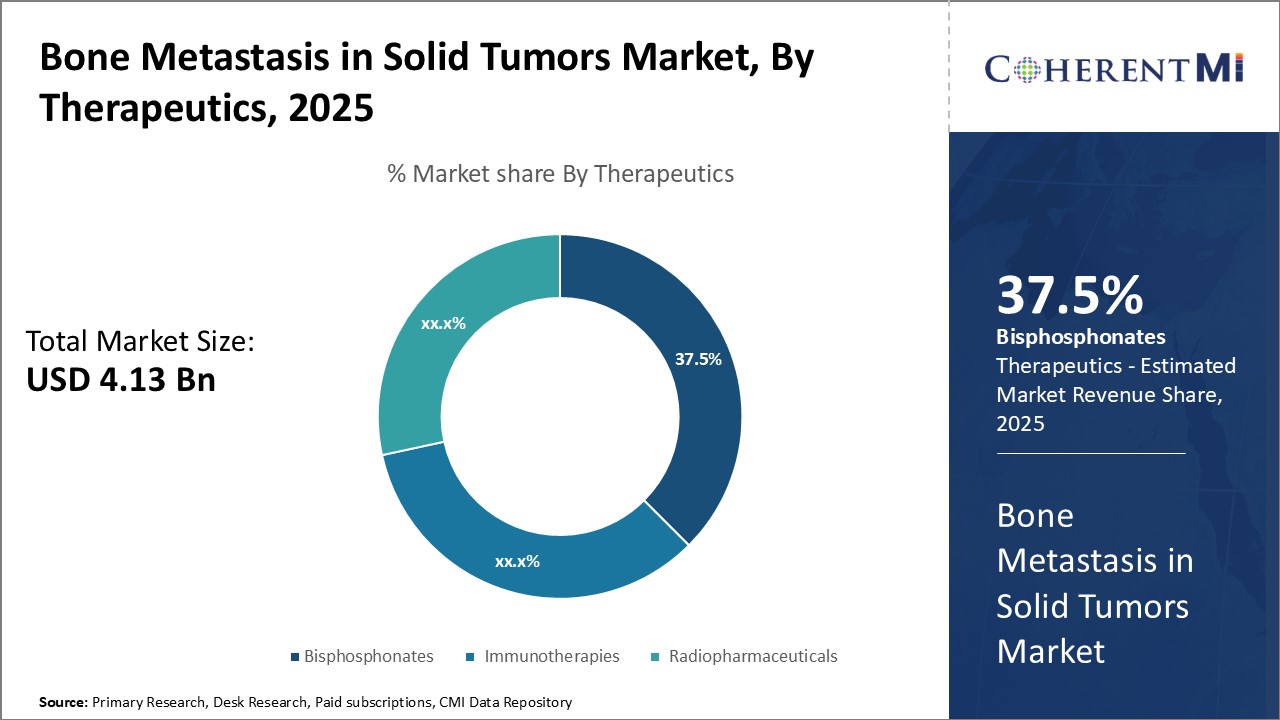Bone Metastasis in Solid Tumors Market Size - Analysis
Market Size in USD Bn
CAGR8.7%
| Study Period | 2025-2032 |
| Base Year of Estimation | 2024 |
| CAGR | 8.7% |
| Market Concentration | High |
| Major Players | Amgen Inc., Novartis AG, Pfizer Inc., Bayer AG, Johnson & Johnson Services, Inc. and Among Others |
please let us know !
Bone Metastasis in Solid Tumors Market Trends
The increasing occurrence of cancer cases across the globe has led to a proportional rise in bone metastases. Rising obesity levels linked to unhealthy diets and lack of physical activity have major implications for cancers like breast and colorectal which demonstrate skeletal metastatic tendencies.
Overall, the compounding effects of an expanding and aging demographic profile coupled with surrounding societal trends mean primary cancer diagnoses will keep mounting. Due to the nature of this disease wherein cells can spread from the initial tumor site, even cancers with historically lower bone metastasis potentials may manifest this complication in greater frequency going forward among larger patient pools. With bones representing such a common secondary site, it is intuitive that bone metastasis case volumes must also rise proportionately.
Market Driver - Advances in Diagnostic Technologies and Treatment Modalities
Modern systemic therapies are also offering expanded options for interfering with the pathobiology of bone metastases. Improved variants of bisphosphonates and RANK ligand inhibitors offer enhanced skeletal protection against complications. Additionally, a diverse portfolio of molecularly-targeted drugs, immunotherapies and other novel agents provide opportunities to not just palliate pain but also potentially restrict further tumor growth and spread.
With continuing therapeutic refinement as well as expanding clinical experience, bone metastasis management protocols are becoming increasingly optimized. This stimulates demand for the various diagnostic tools, medications, and procedures applicable across the disease continuum from early identification to long-term management. Their cumulative impact drives growth of the overall bone metastasis in solid tumors market.

The bone metastasis in solid tumors market faces significant challenges in the high cost of treatment options available. Current treatment approaches such as chemotherapy, radiation therapy, and supportive therapies like pain management medications often require long-term usage to effectively manage the complex symptoms of bone metastases. This long-term treatment burden leads to substantial costs not only for healthcare systems and payers but also out-of-pocket costs for patients.
Furthermore, many bone metastasis patients are elderly who are often on fixed incomes, making it difficult for them to afford high treatment expenses. The high barrier to access effective therapies poses a major barrier to quality of life and clinical outcomes for bone metastasis patients.
Market Opportunity - Development of New Targeted Therapies
Several biopharmaceutical companies are conducting clinical trials for novel targeted agents aimed at proteins like DLL4, NRP2, PD-1, and TGF-β among others that play roles in the formation of bone metastases. The successful development of effective and well-tolerated targeted therapies can transform treatment approaches by delivering superior outcomes compared to traditional options like chemotherapy.
Prescribers preferences of Bone Metastasis in Solid Tumors Market
Bone metastases are generally treated based on the stage and extent of disease. For early stage or localized bone metastasis, prescribers commonly start with non-opioid analgesics like acetaminophen as the first line of treatment to manage pain.
For advances stages with increasing number of sites of bone metastasis, prescribers prefer stronger opioid analgesics like morphine as the third line of treatment. Extended-release formulations of morphine sulfate under brand names like Kadian are preferred to achieve round-the-clock pain relief.
Additionally, factors like performance status, prognosis, goals of care, side effect profile, insurance coverage and patient affordability influence the specific medication prescribed by oncologists and palliative care specialists for advanced bone metastatic cancers.
Treatment Option Analysis of Bone Metastasis in Solid Tumors Market
Bone metastasis is generally classified into 4 stages - asymptomatic, localized pain, functional impairment, and Spinal cord/bone pathology.
As the disease progresses to localized bone pain, radiation therapy can provide effective pain palliation. Stereotactic Body Radiotherapy or SBRT allows delivery of a high dose of radiation precisely to the tumour site in 1-5 sessions, minimizing damage to surrounding healthy tissues.
The final stage with spinal cord/bone compression often requires surgical intervention for decompression and stabilization in addition to the above treatments. Radium-223 dichloride, a novel alpha-emitting radiopharmaceutical, has shown overall survival benefits for castration-resistant prostate cancer patients with symptomatic bone metastases by targeting bone tissues while sparing the marrow.
Key winning strategies adopted by key players of Bone Metastasis in Solid Tumors Market
Collaboration for drug development has been a popular strategy adopted by leading players to advance their pipeline of drugs for bone metastasis treatment. For example, Novartis partnered with MorphoSys in 2018 to develop and commercialize MOR202/TJ202, an anti-CD38 antibody for multiple myeloma treatment including bone lesions. This allows both companies to leverage their collective R&D capabilities and resources.
Customized drug delivery systems have proven effective at improving outcomes. Merck & Co adopted this strategy with their FDA-approved drug called SIMPONI ARIA which uses sophisticated identity recognition to deliver customized treatment directly to disease sites like bone metastases.
Segmental Analysis of Bone Metastasis in Solid Tumors Market
 Insights, By Therapeutics: >Bisphosphonates Witnesses a Rise in Adoption across End Users
Insights, By Therapeutics: >Bisphosphonates Witnesses a Rise in Adoption across End UsersIn terms of therapeutics, bisphosphonates contribute the highest share of the market owing to its widespread adoption across end-users for the management of cancer-related bone diseases. Bisphosphonates are analogs of inorganic pyrophosphate that bind strongly to the bone mineral hydroxyapatite. This binding allows bisphosphonates to effectively reduce osteoclast activity and consequently bone resorption. The anti-resorptive properties of bisphosphonates have proven highly effective in relieving cancer-related skeletal complications such as bone pain, hypercalcemia, pathological fractures, and spinal cord compression. Bisphosphonates are also found to reduce the incidence of bone complications in patients with various solid tumors affecting the bone including breast cancer and prostate cancer. The easy administration and low cost of bisphosphonates compared to alternative therapeutics have spurred their adoption across hospitals, cancer care centers, and clinics. Wide physician recommendation and patient preference for bisphosphonates over other therapeutic classes also contribute to the segment's high value share.
Insights, By Diagnostics: Imaging Dominates Diagnostics with Wide Application in Detecting Skeletal Lesions
However, nuclear bone scans and MRI offer higher sensitivity in detecting bone involvement, especially at an early stage. The non-invasive nature and widespread accessibility of imaging modalities have cemented their role as the standard of care for initial identification and subsequent monitoring of bone metastasis. Advances in imaging technologies with improved resolution and fewer side effects also support continued dominance of the segment.
Insights, By Treatment Option: Surgery Drives Treatment Driven by Capacity to Improve Quality of Life
Surgical procedures aid in stabilizing fractures, correcting spinal deformities, restoring mobility by replacing fractured bones, and alleviating persistent pain associated with bone metastasis. Such pain relief and restoration of motor functions has proven crucial in bolstering patients' quality of life during advanced cancer stages. The capacity of surgical approaches to address aggressive skeletal complications more effectively than alternative options also drives its adoption.

Competitive overview of Bone Metastasis in Solid Tumors Market
The major players operating in the Bone Metastasis in Solid Tumors Market include Amgen Inc., Novartis AG, Pfizer Inc., Bayer AG, and Johnson & Johnson Services, Inc.
Bone Metastasis in Solid Tumors Market Leaders
- Amgen Inc.
- Novartis AG
- Pfizer Inc.
- Bayer AG
- Johnson & Johnson Services, Inc.
Bone Metastasis in Solid Tumors Market - Competitive Rivalry

Bone Metastasis in Solid Tumors Market
(Dominated by major players)
(Highly competitive with lots of players.)
Recent Developments in Bone Metastasis in Solid Tumors Market
- In June 2024, Amgen Inc. announced the development of a new immunotherapy targeting bone metastases in prostate cancer, which is expected to improve survival rates by 20%. This development represents a significant advancement in personalized treatment options. Amgen Inc. is actively working on novel immunotherapies for advanced prostate cancer, specifically targeting bone metastases, which is a common and challenging progression in this disease. Their investigational BiTE (bispecific T-cell engager) therapies, such as AMG 160 and AMG 212, are showing promise in early clinical trials.
- In April 2024, Novartis AG partnered with a leading diagnostics company to enhance bone metastasis imaging technologies, enabling earlier detection and treatment planning. Novartis has been actively involved in the development of radiopharmaceuticals, including imaging agents like Locametz®, which is used to identify prostate cancer metastasis through advanced imaging techniques. These efforts align with Novartis' broader focus on improving diagnostic capabilities for metastatic cancers, including those involving bone
Bone Metastasis in Solid Tumors Market Segmentation
- By Therapeutics
- Bisphosphonates
- Immunotherapies
- Radiopharmaceuticals
- By Diagnostics
- Imaging
- Biomarker Testing
- Biopsy
- By Treatment Option
- Surgery
- Radiation Therapy
- Chemotherapy
- By Disease Management
- Pain Management
- Rehabilitation

Would you like to explore the option of buying individual sections of this report?
Ghanshyam Shrivastava - With over 20 years of experience in the management consulting and research, Ghanshyam Shrivastava serves as a Principal Consultant, bringing extensive expertise in biologics and biosimilars. His primary expertise lies in areas such as market entry and expansion strategy, competitive intelligence, and strategic transformation across diversified portfolio of various drugs used for different therapeutic category and APIs. He excels at identifying key challenges faced by clients and providing robust solutions to enhance their strategic decision-making capabilities. His comprehensive understanding of the market ensures valuable contributions to research reports and business decisions.
Ghanshyam is a sought-after speaker at industry conferences and contributes to various publications on pharma industry.
Frequently Asked Questions :
How big is the bone metastasis in solid tumors market?
The bone metastasis in solid tumors market is estimated to be valued at USD 4.13 billion in 2025 and is expected to reach USD 7.41 billion by 2032.
What are the key factors hampering the growth of the bone metastasis in solid tumors market?
The high cost of treatment options and limited awareness about bone metastasis therapies in emerging markets are the major factors hampering the growth of the bone metastasis in solid tumors market.
What are the major factors driving the bone metastasis in solid tumors market growth?
The rising prevalence of cancer, which leads to increased cases of bone metastasis, and advances in diagnostic technologies and treatment modalities are the major factors driving the bone metastasis in solid tumors market.
Which are the leading therapeutics in the bone metastasis in solid tumors market?
The leading therapeutics segment is bisphosphonates.
Which are the major players operating in the bone metastasis in solid tumors market?
Amgen Inc., Novartis AG, Pfizer Inc., Bayer AG, and Johnson & Johnson Services, Inc. are the major players.
What will be the CAGR of the bone metastasis in solid tumors market?
The CAGR of the bone metastasis in solid tumors market is projected to be 8.7% from 2025-2032.